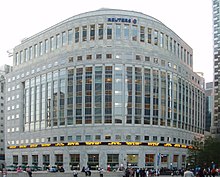Economy of London: Difference between revisions
No edit summary |
(No difference)
|
Revision as of 15:00, 6 November 2006

London is a major centre for international business and commerce and is one of three "command centres" for the global economy (along with New York City and Tokyo).[1]
As Europe's largest city economy, year-by-year, London's economy generates approximately 19% of the UK's GDP[2] or US$418 billion in 2005; whilst the entire London metropolitan area generates approximately 30% of UK GDP or US$660 billion in 2005.[3]
London shifted to a mostly service-based economy earlier than other European cities, particularly following the Second World War. London's relative success as a service industry and business centre can be attributed to a large array of factors: English becoming the new lingua franca, its former position as the capital of the British Empire, its close relationship with the US and various countries in Asia, English law being the most important and most used contract law in international business, the multi-cultural infrastructure (schools, worshipping places, cultural and social organisations), relatively low taxes, particularly for foreigners - non-UK domiciled residents do not get taxed on their foreign earnings, a business friendly environment (e.g. in the City of London the local government is not elected by the resident population but instead by business - the City of London is a business democracy), good transport infrastructure, particularly its aviation industry and a deregulated economy with little intervention by the government.
Currently, over 85% (3.2 million) of the employed population of greater London works in the services industries. Another half a million employees resident in Greater London work in manufacturing and construction, almost equally divided between both.[citation needed]
London has six major business districts: the City, Westminster, Canary Wharf, Croydon, Camden & Islington and Lambeth & Southwark. One way to get an idea of their relative importance is to look at relative amounts of office space: Greater London had 26,721,000 sq m of office space in 2001.
| Business District | Office Space (m²) | Business Concentration |
|---|---|---|
| The City | 7,740,000 | finance, broking, insurance, legal |
| Westminster | 5,780,000 | head offices, real estate, private banking, hedge funds, government |
| Camden & Islington | 2,294,000 | creative industries, finance, design, art, fashion, architecture |
| Canary Wharf | 2,120,000 | banking, media, legal |
| Lambeth & Southwark | 1,780,000 | accountancy, consultancy, local government |
London's largest industry remains finance, and its financial exports make it a large contributor to the UK's balance of payments.[4] The City is the largest financial and business centre in Europe, home to banks, brokers, insurers and legal and accounting firms. A second, smaller financial district is developing at Canary Wharf to the east of the City which includes the global headquarters of HSBC, Reuters, Barclays and many of the largest law firms in the world. London handled 31% of global currency transactions in 2005 — an average daily turnover of US$753 billion — with more US dollars traded in London than New York, and more Euros traded than in every other city in Europe combined.[5] [6]

More than half of the UK's top 100 listed companies (the FTSE 100) and over 100 of Europe's 500 largest companies are headquartered in central London. Over 70% of the FTSE 100 are located within London's metropolitan area, and 75% of Fortune 500 companies have offices in London.
Along with professional services, media companies are concentrated in London (see Media in London) and the media distribution industry is London's second most competitive sector.[7] The BBC is a key employer, other broadcasters also have headquarters around the city. Many national newspapers are edited in London, having traditionally been associated with Fleet Street in the City, they are now primarily based around Canary Wharf. Soho is the centre of London's post-production industry.
Tourism is one of London's prime industries and employed the equivalent of 350,000 full-time workers in London in 2003[8], whilst annual expenditure by tourists is around £15bn.[9] London is a popular destination for tourists, attracting 27 million overnight-stay visitors every year, second only to Paris.[10]
From being the largest port in the world, the Port of London is now only the third-largest in the United Kingdom, handling 50 million tonnes of cargo each year.[11] Most of this actually passes through Tilbury, outside the boundary of Greater London.
See also
- ^ Sassen, Saskia (2001). The Global City: New York, London, Tokyo (2nd edition ed.). Princeton University Press.
{{cite book}}:|edition=has extra text (help) - ^ "London's Place in the UK Economy, 2005-6", p8, Oxford Economic Forecasting on behalf of the Corporation of London. (Figure uses 2002 prices.). Published November 2005. Accessed 19 June 2006. Template:PDFlink
- ^ "The Economic Positioning of Metropolitan Areas in North Western Europe", The Institute for Urban Planning and Development of the Paris Ile-de-France Region, December 2002.]]
- ^ "Financial Services", UK Trade & Investment, 11 May 2006. URL accessed on 3 June 2006.
- ^ "Triennial Central Bank Survey", Bank for International Settlements, March 2005. URL accessed on 3 June 2006. Template:PDFlink
- ^ "Key facts", Corporation of London. URL accessed on 19 June 2006.
- ^ "London's Place in the UK Economy, 2005-6", p19, Oxford Economic Forecasting on behalf of the Corporation of London. Published November 2005. Accessed 19 June 2006. Template:PDFlink
- ^ "London is the HR centre of opportunity in the UK", PersonnelToday.com, 15 February 2005. URL accessed on 3 June 2006.
- ^ "The Importance of Tourism in London", Visit London. URL accessed on 3 June 2006.
- ^ "London 101: One Hundred and One Amazing Facts About London", Visit London. URL accessed on 3 June 2006. Template:PDFlink
- ^ "Trade Statistics", Port of London Authority, Annual Report and Accounts 2005. URL accessed on 3 June 2006.
